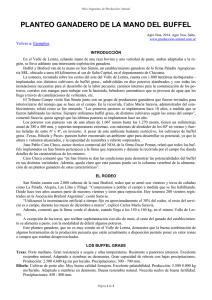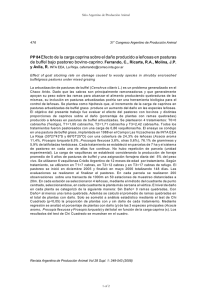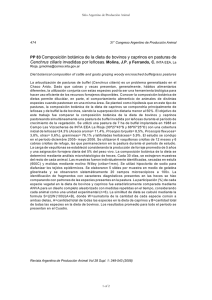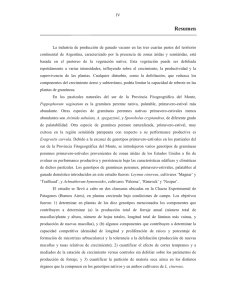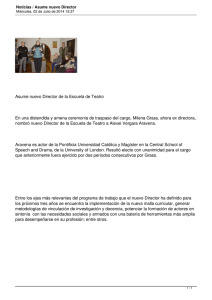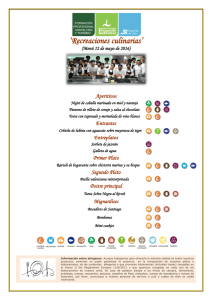Valor nutricional y digestión ruminal de cinco líneas apomíticas y un
Anuncio
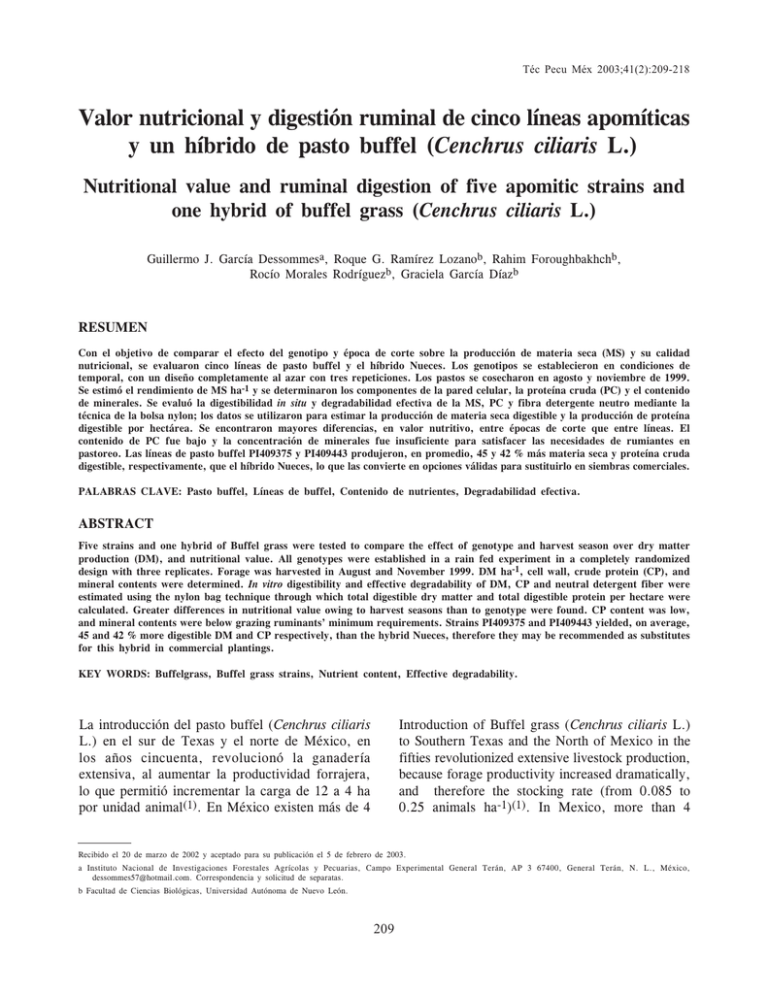
VALOR NUTRICIONAL DE GENOTIPOS DE ZACATE BUFFEL Téc Pecu Méx 2003;41(2):209-218 Valor nutricional y digestión ruminal de cinco líneas apomíticas y un híbrido de pasto buffel (Cenchrus ciliaris L.) Nutritional value and ruminal digestion of five apomitic strains and one hybrid of buffel grass (Cenchrus ciliaris L.) Guillermo J. García Dessommesa, Roque G. Ramírez Lozanob, Rahim Foroughbakhchb, Rocío Morales Rodríguezb, Graciela García Díazb RESUMEN Con el objetivo de comparar el efecto del genotipo y época de corte sobre la producción de materia seca (MS) y su calidad nutricional, se evaluaron cinco líneas de pasto buffel y el híbrido Nueces. Los genotipos se establecieron en condiciones de temporal, con un diseño completamente al azar con tres repeticiones. Los pastos se cosecharon en agosto y noviembre de 1999. Se estimó el rendimiento de MS ha-1 y se determinaron los componentes de la pared celular, la proteína cruda (PC) y el contenido de minerales. Se evaluó la digestibilidad in situ y degradabilidad efectiva de la MS, PC y fibra detergente neutro mediante la técnica de la bolsa nylon; los datos se utilizaron para estimar la producción de materia seca digestible y la producción de proteína digestible por hectárea. Se encontraron mayores diferencias, en valor nutritivo, entre épocas de corte que entre líneas. El contenido de PC fue bajo y la concentración de minerales fue insuficiente para satisfacer las necesidades de rumiantes en pastoreo. Las líneas de pasto buffel PI409375 y PI409443 produjeron, en promedio, 45 y 42 % más materia seca y proteína cruda digestible, respectivamente, que el híbrido Nueces, lo que las convierte en opciones válidas para sustituirlo en siembras comerciales. PALABRAS CLAVE: Pasto buffel, Líneas de buffel, Contenido de nutrientes, Degradabilidad efectiva. ABSTRACT Five strains and one hybrid of Buffel grass were tested to compare the effect of genotype and harvest season over dry matter production (DM), and nutritional value. All genotypes were established in a rain fed experiment in a completely randomized design with three replicates. Forage was harvested in August and November 1999. DM ha-1, cell wall, crude protein (CP), and mineral contents were determined. In vitro digestibility and effective degradability of DM, CP and neutral detergent fiber were estimated using the nylon bag technique through which total digestible dry matter and total digestible protein per hectare were calculated. Greater differences in nutritional value owing to harvest seasons than to genotype were found. CP content was low, and mineral contents were below grazing ruminants minimum requirements. Strains PI409375 and PI409443 yielded, on average, 45 and 42 % more digestible DM and CP respectively, than the hybrid Nueces, therefore they may be recommended as substitutes for this hybrid in commercial plantings. KEY WORDS: Buffelgrass, Buffel grass strains, Nutrient content, Effective degradability. La introducción del pasto buffel (Cenchrus ciliaris L.) en el sur de Texas y el norte de México, en los años cincuenta, revolucionó la ganadería extensiva, al aumentar la productividad forrajera, lo que permitió incrementar la carga de 12 a 4 ha por unidad animal(1). En México existen más de 4 Introduction of Buffel grass (Cenchrus ciliaris L.) to Southern Texas and the North of Mexico in the fifties revolutionized extensive livestock production, because forage productivity increased dramatically, and therefore the stocking rate (from 0.085 to 0.25 animals ha-1)(1). In Mexico, more than 4 Recibido el 20 de marzo de 2002 y aceptado para su publicación el 5 de febrero de 2003. a Instituto Nacional de Investigaciones Forestales Agrícolas y Pecuarias, Campo Experimental General Terán, AP 3 67400, General Terán, N. L., México, [email protected]. Correspondencia y solicitud de separatas. b Facultad de Ciencias Biológicas, Universidad Autónoma de Nuevo León. 209 Guillermo J. García Dessommes, et al. / Téc Pecu Méx 2003;41(2):209-218 millones de hectáreas de pasto buffel(2), que en su mayoría provienen de una sola línea o genotipo, la T-4464 o buffel común, limitando la posibilidad de obtener mayor productividad forrajera, no obstante que existen más de 800 líneas clasificadas de este pasto en el Banco Mundial de buffel en la Universidad de Texas A&M, EUA(3). millions ha, most of them of the T-4464 genotype, or common Buffel grass, have been planted, limiting thus an increase of current forage production, as more than 800 lines are recorded in the World Buffel Grass gene bank in Texas A&M(3). In vitro digestibility fluctuates between 40 and 60 % and crude protein (CP) contents varies in accordance with the plants growth stages, like this, in active development CP could be near to 19 %, while in ear formation it can go down to 11 % in vegetative maturity 8 % and in dry periods to between 2 and 4 %(4,5,6,). Besides, nutritional value differences between diverse buffel grass genotypes have been established and cell wall, protein content and dry matter digestibility is different in stems and leaves(7,8,9). La digestibilidad in vitro de la materia seca del buffel varía de 40 a 60 %, y su contenido de proteína cruda dependiendo del estado de madurez de la planta; así, en la etapa de crecimiento activo tiene 19 %, mientras que durante la formación de espigas, disminuye a 11 % y, en el periodo de madurez vegetativa y durante la época de sequía solamente contiene 8 % y de 2 a 4 % de PC, respectivamente(4,5,6). Asimismo, se han encontrado diferencias en el valor nutritivo entre las variedades e híbridos del pasto buffel. Además, el contenido de proteína, paredes celulares y digestibilidad de la materia seca difiere considerablemente entre hojas y tallos(7,8,9). In January and February and during prolonged dry spells or droughts, protein should be supplemented to cattle grazing buffel grass, as long as in the rest of the year an adequate amount of forage, capable of meeting daily energy demands is available. Phosphorous content fluctuates with rainfall, and should be supplemented throughout the whole year. However, Ca, K, Mg, Zn, Mn, Fe and Na contents seem to be adequate(10,11). Durante enero a febrero y durante los períodos de sequía, parece ser necesario el aporte adicional de proteína a bovinos en pastoreo en praderas de pasto buffel, siempre y cuando exista, el resto del año, suficiente forraje para satisfacer las demandas diarias de energía. La concentración de fósforo fluctúa en respuesta a la precipitación y se requiere suplementar durante todo el año; sin embargo, los niveles de Ca, K, Mg, Na, Zn, Mn y Fe aparentemente son adecuados durante el año(10,11). Some buffel grass genotypes display higher forage production and capacity to adapt than commercial hybrids and varieties (12). Unfortunately, their nutritional quality is unknown and also valid comparison among them in terms of digestibility and nutrient content. The objectives of this study were to study effects of genotype and climate on dry matter production and nutritional quality in rainfed buffel grass. Existen genotipos de pasto buffel con una mayor productividad forrajera y adaptación que las variedades e híbridos comerciales(12), pero se desconoce su calidad nutritiva, y establecer una comparación válida entre estos, en términos de contenido de nutrientes y digestibilidad. Los objetivos del presente trabajo fueron estudiar el efecto del genotipo y la época del año en la producción de materia seca y valor nutritivo del pasto buffel en condiciones de temporal. El experimento se mental de General 25º 18 Norte y temperatura media The experiment was carried out in INIFAPs General Teran Experimental Station at 25° 18' N and 99° 35' W longitude, 22.4 ºC average, 36.1 ºC average maximum and 9.3 ºC average minimum temperatures respectively, with an average rainfall of 784 mm and evaporation 1,622 mm. Photoperiod averages 4,439 h annually and solar radiation 143,272 calories cm2 . Soils are classified as Vertisols, showing a 7.9 to 8.2 pH with high CaCO3 content. localizó en el Campo ExperiTerán, del INIFAP, situado a 99º 35 Oeste a 332 msnm, anual de 22.4 ºC, máxima y 210 VALOR NUTRICIONAL DE GENOTIPOS DE ZACATE BUFFEL Five buffel grass lines - PI-307622(Pl1), PI409252(Pl2), PI-409375(Pl3), PI-409443(Pl4) and PI-409460(Pl5) - and the Nueces buffel grass hybrid were tried in 4 m2 plots (useful plot=0.8 m2) in a completely randomized experimental design with three replicates per treatment. To standardize growth a general clipping was carried out on March 1, 1999. The first worthwhile rainfall fell on May 27, which unleashed grass growth. Assessments were carried out in the same timeframe for all treatments on August 10, at the full flowering stage, 75 d after regrowth, and on November 1, 81 d after regrowth, by cutting complete plants in each plot at a 0.15 m height. mínima promedio de 36.1 y 9.3 ºC respectivamente. La precipitación pluvial promedio anual de 784 mm, con una evaporación de 1,622 mm al año. El fotoperíodo tiene una duración de 4,439 h al año y la radiación solar corresponde a 143,272 calorías cm2. Los suelos son de tipo aluvión y se clasifican como unidades Vertisol, con un pH de 7.9 a 8.2 con alto contenido de carbonatos de calcio(13). Se utilizaron cinco líneas de zacate buffel: PI307622 (PI1), PI-409252 (PI2), PI-409375 (PI3), PI-409443 (PI4), PI-409460 (PI5) y el híbrido Nueces, las cuales fueron establecidas en parcelas de 4 m2 (parcela útil de 0.8 m2), en condiciones de temporal, bajo un diseño completamente al azar con tres repeticiones por tratamiento. Para uniformar el crecimiento de los pastos se dio un corte general el 1 de marzo de 1999. La primera precipitación pluvial apreciable del año se presentó el 27 de mayo, lo que dio inicio al crecimiento del pasto. La evaluación de los pastos se realizó al mismo tiempo, cuando alcanzaron plena floración el 10 de agosto, con 75 días de edad al rebrote y el 1 de noviembre a 81 días de rebrote, cortando las plantas completas de cada parcela a una altura de 15 cm del suelo. Rainfall between May 27 and August 10 totaled 329 mm, evaporation 643 mm, average maximum temperature and average minimum temperature were equal to 35 and 22 °C respectively. Rainfall between the first and second clippings was 183 mm, evaporation 437 mm and average maximum and minimum temperatures 32 °C and 18 °C respectively. As rainfall was 34 % below the average, this growth season can be considered as dry. To determine partial dry matter, fresh forage was weighed and afterwards placed in a stove at 55 °C till constant weight. Once dry, leaves were separated from stems by means of stainless steel scissors. All samples were grounded in a Wiley mill fitted with 1 mm sieves. La precipitación entre el 27 de mayo y el 10 de agosto fue de 329 mm, una evaporación de 643 mm, temperatura media máxima y mínima de 35 y 22 ºC respectivamente. La precipitación total recibida entre el primer corte y el segundo, en noviembre, fue de 183 mm, evaporación de 437 mm, temperatura media máxima y mínima de 32 y 18 ºC respectivamente. La precipitación registrada se encontró un 34 % por debajo de la media histórica del sitio, por lo que se consideró como un año seco. Dry matter (DM), organic matter (OM), ashes, crude protein (CP) (14) , neutral detergent fiber(NDF), acid detergent fiber(ADF), hemicellulose (HEM), cellulose (CEL) and lignin (LDA) were analyzed(15,16) as well as the following nitrogen fractions in the cell wall: insoluble N in neutral detergent (INNDF), insoluble N in acid detergent(INADF) and slowly degraded N (INNDFINADF)(17). Para determinar materia seca parcial, se pesó el forraje en verde, y posteriormente se colocó en una estufa a 55 °C hasta alcanzar peso constante. Una vez secas, se separaron las hojas de los tallos con tijeras de acero inoxidable. Todas las muestras fueron molidas en un molino Wiley con una malla de 1 mm. DM, CP and NDF in situ digestibility were determined by means of the nylon bag technique. Four Rambouillet x Pelibuey (45 ± 2 kg live weight) castrated and fistulated lambs were used. For each grass, and for each replicate and cut, two lambs were used; for each analysis seven bags (0.05 x 0.10 m and 53 mm pore), each containing a 4 g Se determinó el contenido de materia seca (MS), materia orgánica (MO), cenizas, proteína cruda 211 Guillermo J. García Dessommes, et al. / Téc Pecu Méx 2003;41(2):209-218 (PC)(14), fibra detergente neutro (FDN), fibra detergente ácido (FDA), hemicelulosa, celulosa y lignina (LDA)(15,16), y las fracciones nitrogenadas de la pared celular: N insoluble en detergente neutro (NIFDN), N insoluble en detergente ácido (NIFDA) y N degradado lentamente (NIFDN-NIFDA)(17). ground sample, were used. These bags were introduced and suspended in the lower part of the rumen, for the following incubation sequence: 4, 8, 12, 24, 36 and 48 h. Disappearance of material at 0 hours was estimated in a seventh bag which was not incubated and also placed in the rumen, being washed the same as the others. In the course of the test, lambs were fed freely with alfalfa hay. Afterwards, bags were dried at 55 ºC for 48 h in a stove. The residue in each bag was for DM, CP, and NDF content(14,15), and whose disappearance percentage was estimated through differences in accordance with the Oskov and McDonald method (18) . Non linear parameters and DM (DMDE), CP (CPDE) and NDF (NDFDE) effective degradability were estimated by means of the Neway software(19). DMDE, CPDE and NDFDE were calculated through a 2 %/h ruminal exchange rate, which is in itself a low intake level(20). La digestibilidad in situ de la MS, PC y FDN se determinó utilizando la técnica de la bolsa nylon, para lo cual se usaron cuatro borregos (Rambouillet x Pelibuey) castrados y fistulados del rumen de 45±2 kg de peso vivo. Para cada pasto, en cada repetición y en cada corte se usaron dos borregos. Para cada corrida se utilizaron siete bolsas nylon (5 x 10 cm y 53 mm de tamaño de poro), que contenían cada una 4 g de muestra molida; seis bolsas se introdujeron y suspendieron en la parte ventral del rumen, con una secuencia de incubación de 4, 8, 12, 24, 36 y 48 h. La desaparición del material en la hora cero, fue estimada en la séptima bolsa sin incubar en el rumen, lavándola de la misma manera que las demás. Durante la prueba, los borregos fueron alimentados con heno de alfalfa a libre acceso. Posteriormente, las bolsas fueron secadas en una estufa a 55 ºC durante 48 h; al residuo de cada bolsa en cada periodo de incubación se le determinó su contenido de MS, PC y FDN(14,15), cuyo porcentaje de desaparición se estimó por diferencia, utilizando la ecuación de Oskov y McDonald(18). Los parámetros no lineales, así como la degradabilidad efectiva de la MS (DEMS), PC (DEPC) y FDN (DEFDN), fueron calculadas por medio del paquete computacional Neway (19) . DEMS, DEPC y DEFDN fueron estimadas usando una tasa de recambio ruminal de 2 %/h, la cual representan un nivel bajo de consumo(20). Values obtained in all variables were analyzed through a completely randomized experimental design with three replicates and a 6 x 2 factorial arrangement. Factor A were the genotypes and Factor B the clipping dates. Treatment averages were split through the significant minimum differences method(21). Para la determinación de minerales, las muestras de cada línea y cada corte fueron incineradas en una mufla a 550 ºC durante 4 h. Posteriormente las cenizas fueron digeridas en una solución de HCL y HNO3, usando la técnica de la digestión húmeda. Los contenidos de los minerales Ca, Na, K, Mg, Cu, Zn, Fe, Mn, Co y Mo en las muestras fueron estimados por medio de espectrofotometría de absorción atómica. La concentración de P se calculó usando un colorímetro(14). Differences in total DM between genotypes were established (P≤0.05). Pl4 produced a higher dry matter amount when compared to Pl5 and Nueces, but a similar quantity than the other genotypes (Table 1). In percentage terms, Pl4 produced 46 % more dry forage than Nueces, besides producing the higher leaf quantity when compared to other lines being assessed. Even though rainfall was higher in summer, the rainfall/evaporation ratio was similar for the two periods considered (0.4 vs To determine mineral (Ca, Na, K, Mg, Cu, Zn, Mn, Co and Mo) content, samples of each line and clipping were calcinated in a muffle oven at 550 ºC for 4 h. Afterwards the remaining ashes were digested in an HCl and HNO3 solution, using the humid digestion technique. Mineral content was determined by means of an atomic absorption spectrophotometer. P content was determined through a colorimeter(14). 212 VALOR NUTRICIONAL DE GENOTIPOS DE ZACATE BUFFEL Los valores obtenidos en todas las variables fueron analizados según un diseño completamente al azar con tres repeticiones y con arreglo factorial de 6 x 2. El factor A fueron los genotipos y el factor B las épocas de corte. Las medias de los tratamientos fueron separadas con el método de diferencia mínima significativa(21). 0.5), so no seasonal variations in production between the two periods were found (P≥0.05). Nor was genotype interaction between periods significant, which is an index of forage production stability. These findings are in coincidence with previous reports in which more lines, clippings and years were considered (12) . The higher productivity of some of these buffel grass lines when compared to Nueces had already been published and results showed that forage quantity produced in summer is similar to that produced in fall and those genotypes which produce more, do so in both seasons. Besides, new buffel grass lines carry more DM production potential than Nueces. La producción de materia seca total (MST) fue diferente (P≤0.05) entre genotipos. La PI4 produjo la mayor cantidad de MST comparada con el híbrido Nueces y PI5, siendo similar (P≥0.05) a los otros pastos (Cuadro 1). En términos porcentuales, la línea PI4 produjo 46 % más forraje seco que el híbrido Nueces; además, la PI4 obtuvo la mayor (P≤0.05) cantidad de hojas comparada con las otras líneas evaluadas. Aún cuando se registró mayor Significant differences (P≤0.05) in DM, ADF, HEM and LDA were found, but NDF and CEL Cuadro 1. Producción de materia seca y calidad nutritiva de cinco líneas y un híbrido de pasto buffel (Cenchrus ciliaris L), en dos épocas del año bajo condiciones de temporal Table 1. Dry Matter production and nutritional quality in five buffel grass (Cenchrus ciliaris L) lines and one hybrid, in two seasons under rainfed conditions Genotype Nueces DM %H OM NDF ADF HEM CEL LDA CP INND INAD INND-INAD DDM DCP PI 1 PI 2 3.2c 4.9ab 4.6abc b c 52.0 48.7c 58.2 90.1a 88.9b 90.2a 72.5a 70.9a 70.9a b ab 46.2 47.0 45.7b 26.3a 23.8bc 25.2ab 36.4a 36.4a 36.3a ab a 5.3 6.0 4.8b 7.4a 5.7d 6.6bc 41.9bc 47.6a 37.7d 27.4b 34.4a 26.8b b bc 13.7 13.2 10.9c 1.6c 2.6ab 2.2bc 139.7b 183.6b 177.3b PI 3 Season PI 4 PI 5 5.2ab 5.9a 4.1bc c a 49.5 63.5 57.2b 89.1b 88.1c 90.3a 70.9a 68.7a 70.4a a ab 47.6 47.1 47.7a 23.3b 21.7c 22.7c 36.9a 36.9a 36.6a b b 4.7 4.6 6.0a 6.6bc 6.8b 6.3c 39.5cd 40.1cd 44.0b 33.6b 28.3b 26.9b d bc 5.9 11.9 17.1a 2.6ab 3.2a 2.2bc 207.4ab 276.9a 155.0b Aug Nov 4.9a 61.2a 89.3a 72.3a 48.5a 23.8a 38.7a 5.2a 7.0a 44.8a 31.8a 12.8a 2.3a 208.0a 4.5a 48.5b 89.6a 69.1b 45.3b 23.8a 34.5b 5.3a 6.2b 38.7b 27.3b 11.4a 2.5a 172.0a Mean±SE 4.7 ± 0.2 54.8 ± 1.4 89.5 ± 0.1 70.7 ± 0.4 46.9 ± 0.3 23.8 ± 0.4 36.6 ± 0.4 5.2 ± 0.1 6.6 ± 0.1 41.8 ± 1.8 29.6 ± 0.7 12.1 ± 0.8 2.4 ± 0.1 190.2 ±13.0 DM= Dry Matter t ha-1 clipping-1; %H= Leaf weigh ratio plant-1 (g); OM= Organic Matter; NDF= Neutral detergent fiber; ADF= Acid detergent fiber.; HEM= Hemicellulose; CEL= Cellulose; LDA= Lignin; CP= Crude Protein; INND= Insoluble nitrogen in neutral detergent as % of total protein; INAD= Insoluble nitrogen in acid detergent as % of total protein; INND-INAD= Insoluble nitrogen in neutral detergent but soluble in acid detergent as % of total protein; DDM= Digestible dry matter (t ha-1); DCP= Digestible crude protein (kg ha-1). abc Values showing different literals within the same row are different (2≤0.05). 213 Guillermo J. García Dessommes, et al. / Téc Pecu Méx 2003;41(2):209-218 showed similar values between clipping periods. Interaction between genotypes per clipping season was significant (P≤0.05) for OM, ADF and CEL. Therefore cell wall component concentration was consistently higher in summer than in autumn, perhaps due to higher average temperatures in summer than in the fall (29 °C vs 25 °C) which results in less cellular content and in a greater synthesis of cell wall components(22). Crude protein content was low in both seasons, showing a 6.6 % average, concentration practically equal to the minimum requirements for pregnant beef cows. This low rate is due to plant development stage and to low N content in soils(22,23). The positive correlation established between N fertilization and PC concentration in buffel grass(24,25,26) leaves no doubt as to an association between N content in soils and CP concentration in buffel grass plants. Soils in which this experiment was established show N availability problems owing to low N content, high pH, high CO3 concentration and continuous use for more than 40 years (13) . Nevertheless, significant differences (P≤0.05) were found between genotypes and clipping seasons in CP, INNDF and INADF contents. However, non available N (INADF) as a percentage of total N) was high, a 29.6 % average compared to other feeds (3 to 15 % of total N)(22). precipitación durante el verano, el cociente de la precipitación/evaporación fue similar entre las dos épocas (0.5 vs 0.4), por lo que no se encontraron diferencias (P≥0.05) para la producción de forraje entre épocas. Tampoco se observó significancia para la interacción genotipo por época de corte, lo que manifiesta la estabilidad en la producción de forraje de los pastos. Estos efectos coinciden con reportes previos donde se hicieron comparaciones con un mayor número de líneas, cortes y años(12). La mayor productividad de algunas de estas líneas de buffel, comparadas con el híbrido Nueces, ya había sido publicada, y los resultados mostraron que la cantidad de forraje producido durante el verano es similar al producido durante el otoño, y los genotipos más productivos también lo son en todas las épocas de corte. Además, las nuevas líneas de pasto buffel presentan un mayor potencial de producción de MS que el Nueces. Se encontraron diferencias (P≤0.05) en el contenido de MO, FDA, HEM y LDA, pero FDN y CEL fueron similares; mientras que, el contenido de FDN, FDA y CEL fue diferente (P≤0.05) entre épocas de corte. La interacción entre genotipo por época de corte fue significativa (P≤0.05) para MO, FDA y CEL. Así, la concentración de los componentes de las paredes celulares fue consistentemente más elevada en el verano que en el otoño, posiblemente debido a la presencia de temperaturas medias más altas en el verano que en el otoño (29 vs 25 ºC), lo que produce un doble efecto, al disminuir el contenido celular y aumentar la síntesis de los componentes de la pared celular(22). Significant differences (P≤0.05) between genotypes were found in MSDT (estimated as MST x DM degradability) and CPDT (calculated as MST x CP x CP degradability), but were similar between clipping periods, line Pl4 produced double DMDT and CPDT than Nueces. DM, CP and NDF in situ digestibility showed significant differences (P≤0.05) between genotypes and clippings (Table 2). However, differences (P≤0.05) for DMDE and NDFDE were more pronounced between clipping periods than for genotypes, showing the fall clipping more digestibility than that of summer. In the November clipping DM and NDF soluble fractions were greater (P≤0.05) than in August. The relative similarity between diverse genotype digestibility has been mentioned before(27). In the present study line Pl5 showed the higher MSDE, but was very similar to that of Pl1, Pl4 and Nueces. Cell walls El contenido de PC en los genotipos evaluados fue bajo en las dos épocas de corte, con 6.6 % en promedio; esta concentración es prácticamente el nivel mínimo para mantenimiento de las funciones normales del rumen en vacas gestantes para producción de carne(23). Esta baja concentración obedece entre otros factores, al estado de madurez de las plantas cuando se cosecharon, como ya ha sido señalado, y a una baja disponibilidad de Nitrógeno en el suelo(22,23). La relación positiva que se indica entre fertilización nitrogenada y el contenido de PC en el zacate buffel(24,25,26), ha 214 VALOR NUTRICIONAL DE GENOTIPOS DE ZACATE BUFFEL Cuadro 2. Degradabilidad ruminal de la materia seca, fibra y proteína cruda de cinco líneas y un híbrido de pasto buffel (Cenchrus ciliaris L), en dos épocas del año en condiciones de temporal (%)* Table 2. Dry matter, fiber and protein ruminal degradability in five buffel grass (Cenchrus ciliaris L) lines and one hybrid, in two seasons under rainfed conditions (%)* Nueces PI 1 Genotype PI 2 PI 3 PI 4 PI 5 Season Aug Nov Mean±SE DMED Sf If Dr 50.3ab 32.2a 27.6d 5.3a 52.7a 28.1b 41.9ab 3.9bc 48.3b 25.4c 35.7bc 4.8ab 49.3b 53.1a 28.1b 30.3ab 37.2abc 35.3c 4.4abc 5.0ab 53.5a 30.3ab 42.2a 3.6c 47.4b 25.0b 37.5a 4.3a 55.0a 33.1a 35.8a 4.6a 51.2±0.88 29.1±0.87 36.6±1.34 4.5±0.22 CWED Sf If Dr 50.7a 30.7a 30.4b 5.5a 50.9a 26.0b 39.6a 4.8a 43.7b 16.9e 39.1a 5.8a 47.3ab 20.7cd 41.7a 4.8a 45.7b 19.5de 39.5a 5.1a 49.6a 24.0bc 41.4a 4.3a 42.4a 15.7b 42.2a 4.5b 53.6b 30.3a 35.0b 5.7a 48.0±1.23 23.0±1.57 38.6±1.20 5.0±0.19 CPED Sf IF Dr 59.9b 44.2a 24.5b 5.0a 63.5ab 42.6a 34.6a 4.2a 58.2b 38.1a 30.8ab 5.0a 58.6b 39.6a 31.2ab 4.7a 67.7a 51.4a 25.8b 5.1a 59.7b 37.9a 38.4a 3.7a 60.5a 42.7a 29.6b 4.3b 62.1a 42.0a 32.2a 5.0a 61.3±1.11 42.3±1.52 30.9±1.29 4.6±0.20 DMED= Dry matter effective degradability; Sf= Soluble fraction; If= Insoluble fraction, potentially degradable; Dr= Degradability rate (% h-1); CWED= Cell wall effective degradability; CPED= Crude protein effective degradability. abcd Values showing different literals within the same row are different (2≤0.05). *Taking into account a 2 %/h replacement rate. for all genotypes were 20.9 % more digestible in autumn than in summer. As nutrient digestibility differences are higher between seasons than between genotypes, this could indicate that nutritional quality is more climate than genotype dependent. A significant interaction between genotype and clipping season was found for DMDE and NFDDE, which seems to suggest that for these variables climate affects each genotype differently. dejado establecida la asociación entre el nivel de Nitrógeno en el suelo y el contenido de PC en el pasto. Los suelos donde se localizó el experimento presentan problemas de disponibilidad de N, debido a su baja concentración, alto pH, alta concentración de carbonatos y uso continuo por más de 40 años(13). No obstante, se encontraron diferencias (P≤0.05) entre genotipos y épocas de corte en el contenido de PC, NIFDN y NIFDA. El híbrido Nueces presentó el contenido de PC más alto comparado con los zacates evaluados. Sin embargo el N no disponible (NIFDA, como porcentaje del N total) fue alto, con 29.6 % (promedio general) comparado con lo indicado para otros alimentos (3 a 15 % del N total)(22). Forage nutritional quality is closely linked to maturity, and this is a cause for genotype, physiological state, age and climate interaction(22), in Northeast Mexico, rainfall has been said to be the most important variable for nutrient degradability in Common(7) and Nueces(8) buffel grass. Seasonal variations in Buffel Grass digestibility have been mentioned before for other localities(28). Given the climate in this experiment, DM and NFD degradability could have decreased in summer owing to high temperatures, as cell wall content increases and digestibility diminishes. On the other hand, Se encontraron diferencias (P≤0.05) en la MSDT (calculada como la MST x degradabilidad de la MS) y PCDT (calculada como MST x PC x degradabilidad de la PC) entre zacates, pero fueron similares entre épocas de corte; la línea PI4 produjo el doble de MSDT y PCDT que el híbrido Nueces. 215 Guillermo J. García Dessommes, et al. / Téc Pecu Méx 2003;41(2):209-218 climate had no effect on CPDE, as no differences between clipping seasons could be observed, but was positive for this factor in genotypes (P≤0.05). Las características de la digestibilidad in situ de la MS, PC y FDN fueron diferentes (P≤0.05) entre genotipos y entre cortes (Cuadro 2). Sin embargo, las diferencias (P≤0.05) en DEMS y DEFDN fueron más marcadas entre épocas de corte que entre genotipos, siendo el corte de otoño significativamente más digestible que el de verano. En el corte de noviembre la fracción soluble de la MS y FDN fue mayor (P≤0.05) que en agosto. La relativa similitud entre las digestibilidades de diferentes genotipos de pasto buffel ya ha sido mencionada con anterioridad(27). En este estudio la línea PI5 tuvo la DEMS más alta, pero fue similar a PI1, PI4 y al híbrido Nueces, mientras la línea PI1 tuvo mayor (P≤0.05) DEFDN, pero ésta fue similar a las líneas PI3 y PI5 y al híbrido Nueces. Las paredes celulares de todos los zacates fueron, en promedio, un 20.9 % más digestibles en otoño que en el verano. El hecho de que las diferencias en las digestibilidades de los nutrientes fueran más grandes entre épocas que entre pastos, pudiera indicar que la calidad nutritiva fue más dependiente del clima que del genotipo. Se encontró Except for Fe and Na, mineral content showed differences (P≤0.05) between genotypes (Table 3). Except for Cu and Na, mineral content was higher in fall than in summer (P≤0.05). However, mineral content was lower than ruminants requirements in both seasons owing to the causes already explained for N. Assessment of mineral potential intake in a 400 kg cow with a 10.2 kg DM buffel grass daily intake(24) shows that only K, Fe, Co and Mo met its requirements. In the case of P, only 4 % of requirements were met. Phosphorous deficiency in this area has been mentioned before in other papers(10) and results obtained in the present study reaffirm the necessity to supplement this mineral to be able to secure satisfactory production levels. In conclusion greater differences in nutritional value were found between seasons, than between Cuadro 3. Contenido de minerales en cinco líneas y un híbrido de pasto buffel (Cenchrus ciliaris L.) en dos épocas del año en condiciones de temporal Table 3. Mineral content in five buffel grass (Cenchrus ciliaris L.) lines and one hybrid, in two seasons under rainfed conditions Nueces PI 1 Genotype PI 2 PI 3 PI 4 PI 5 Ca* 0.39a 0.38b 0.38b 0.38b 0.38b 0.37c 0.38a 0.37b P* 0.08a 0.07b 0.07b 0.08a 0.07b 0.06c 0.07b 0.08a 0.11a 21.29a 0.49a 2.17a 92.27a 9.63d 27.62b 6.29ab 1.37a 0.11a 19.54b 0.34d 1.80ab 92.75a 11.40cd 28.18ab 6.35ab 1.05bc 0.12a 13.15d 0.38c 1.12a 71.46a 15.39ab 33.52ab 6.16ab 1.15abc 0.10a 15.27c 0.44b 0.86a 86.68a 18.37a 32.84ab 6.50a 1.24ab 0.12a 18.12b 0.38c 1.13c 72.00a 13.43bc 34.79a 6.10bc 0.97cd 0.08a 15.45c 0.44b 1.42b 76.45a 10.38cd 16.97c 5.73c 0.76d Na* K* Mg* Cu** Fe** Zn** Mn** Co** Mo** * g/kg dry matter. ** mg/kg dry matter. abcd Values showing different literals within the same row are different (2≤0.05). 216 Season Aug Nov 0.11a 0.10a a 18.51 15.77b 0.39b 0.44a 1.25a 1.59a 55.27b 108.6a 10.99b 15.22a 26.01b 31.97a 6.45a 5.93b b 0.92 1.26a Mean±SE 0.38±0.002 0.07±0.002 0.12±0.004 17.14±0.59 0.41±0.01 1.42±0.12 81.94±6.05 13.10±0.74 28.99±1.43 6.19±0.08 1.09±0.05 VALOR NUTRICIONAL DE GENOTIPOS DE ZACATE BUFFEL una interacción significativa entre el genotipo y la época de corte para la DEMS y DEFDN, lo que parecería señalar que para estas variables las condiciones climáticas afectan diferencialmente a los genotipos. genotypes. On the contrary, DMDT and CPDT estimated values were similar between seasons, but different between genotypes. Nitrogen levels were consistently low in all genotypes and clipping seasons, most probably to the soil type in which this experiment was carried out. Besides, except for K, Fe, Co and Mo mineral content in all evaluated genotypes was below grazing ruminants requirements. Greater differences were found for total nutrient production than for nutrient quality in the assessed genotypes. Line Pl4, owing to its higher DM production and nutrient degradability, compared to the Nueces hybrid, could be considered as an excellent choice as forage for grazing cattle in Northeastern Mexico. La calidad nutricional de los forrajes está estrechamente ligada a su madurez, y ésta es una causa del efecto de la interacción del genotipo, estado fisiológico, edad y clima(22). En el noreste de México la precipitación pluvial ha sido publicada como la variable climática que mayor efecto presenta sobre la degradabilidad de los nutrientes en zacate buffel Común(7) y buffel Nueces(8). Variaciones estacionales de la digestibilidad del zacate buffel, también se han señalado con anterioridad para otras regiones(28). Dadas las condiciones climáticas en este experimento, se podría inferir que las mayores temperaturas del verano pudieron haber disminuido la degradabilidad de la MS y FDN, al aumentar el contenido de paredes celulares y disminuir su digestibilidad. Por otra parte, el clima no tuvo efecto sobre la DEPC, ya que no hubo diferencias entre épocas de corte, aunque sí entre genotipos (P≤0.05). ACKNOWLEDGMENTS This project couldnt have been possible without funding from SIRYES-CONACYT (project 200060-1006) and from the Fundación Produce Nuevo León, A.C. End of english version Con excepción de Fe y Na, el contenido de todos los minerales fue diferente (P≤0.05) entre genotipos (Cuadro 3). Con excepción del Na y Cu, todos los minerales evaluados fueron mayores en otoño que en verano (P≤0.05); sin embargo, para las necesidades de los rumiantes en pastoreo, el contenido de minerales fue bajo en todos los pastos en las dos épocas del año, por las razones similares a las ya señaladas para explicar los bajos contenidos de N. señalados, a bovinos en pastoreo, para obtener niveles satisfactorios de productividad. En conclusión, las mayores diferencias en valor nutritivo se encontraron entre épocas de corte que entre genotipos. Por el contrario, los valores estimados de MSDT y PCDT fueron similares entre épocas, pero diferentes entre pastos. Los niveles de N fueron consistentemente bajos para todos los zacates y épocas de corte, probablemente como consecuencia del tipo de suelo donde se realizó el experimento. Además, con excepción del K, Fe, Co y Mo la mayoría de los minerales contenidos en todos los genotipos evaluados fueron bajos para satisfacer los requerimientos de los rumiantes en pastoreo. Se encontraron mayores diferencias entre la producción total de nutrientes que entre la calidad nutricional de los pastos evaluados. La línea PI4 por su mayor producción de materia seca y mayor El consumo potencial de los minerales evaluados por una vaca de 400 kg de peso vivo, consumiendo 10.2 kg diarios de materia seca de los pastos evaluados(24), muestra que sólo el K, Fe, Co y Mo fueron adecuados para satisfacer sus requerimientos. En el caso del P, en donde solamente se cubren, en promedio, el 4 % de los requerimientos de este mineral. Deficiencia de P en los forrajes de esta región ya ha sido mencionada en otros trabajos (10) y los resultados de este estudio, muestran la necesidad de complementar este mineral y los otros 217 Guillermo J. García Dessommes, et al. / Téc Pecu Méx 2003;41(2):209-218 degradabilidad de los nutrientes, comparada con el híbrido Nueces, puede ser considerada como un excelente pasto para el ganado en pastoreo en el noreste de México. Proceed Texas A&M Univer Res Exten Center. Weslaco, Texas, 1985:13-24. 11. Ramírez RG, Foroughbackhch R, González-Rodríguez PH ,, Háuad LA, Alba-Avila, J García-Castillo CG. Variación estacional del contenido mineral en la planta completa, hojas y tallos del zacate buffel común (Cenchrus ciliaris L.). Archivos Latinoamericanos de Nutrición 2000 [Recibido para publicación]. 12. García DGJ, Maldonado ALJ. Introducción y evaluación de líneas texanas de buffel (Cenchrus ciliaris L:) en el centro de Nuevo León [resumen]. XIII Congreso sobre manejo de pastizales. Ags. México. 1998:46. AGRADECIMIENTOS 13. INFAP. Memorias segunda reunión científica forestal y agropecuaria del estado de Nuevo León. Centro de Investigación Regional del Noreste, México. 1991:48-50 Este estudio fue financiado por el SIRYESCONACYT (proyecto 2000-60-1006) y la Fundación Produce Nuevo León, A.C. 14.- AOAC. Official methods of analysis. 13th ed. Arlington, VA, USA: Association of Official Analytical Chemists; 1975. 15. Goering HK, Van Soest PJ. Forage fiber analysis. USDA-ARS Agric Handbook 1970(379). 16. Robertson JB, Van Soest PJ. The detergent system of analysis and its application to human foods. In: The analysis of dietary fiber in food. Marcel Dekker, Inc; 1981:123-156. LITERATURA CITADA 1. Hanselka CW. Grazing management strategies for buffel grass (Cenchrus ciliaris L. ). In: Buffelgrass: Adaptation, management and forage quality. Proceed Texas A&M Univer Res Exten Center. Weslaco, Texas, 1985:53-54. 2. Alcalá GCH. Origen geográfico y distribución mundial. En: Guía práctica para el establecimiento, manejo y utilización del zacate buffel. Patrocipes. Hermosillo, Sonora, Mex. 1995:9-14. 3. Bashaw EC. Buffelgrass origins. In: Buffelgrass: Adaptation, management and forage quality. Proceed Texas A&M Univer Res Exten Center. Weslaco, Texas, 1985:6-12. 4. Hussey MA, Bashaw EC. Influence of clipping height on the yield and quality of winterhardy buffelgrass ( Cenchrus ciliaris L.) germplasm. Forage Resarch in Texas. Texas A&M University System. USA. 1985; CPR-4731:37-38. 17. Van Soest PJ, Roberson JB, Lewis BA. Methods of dietary fiber, neutral detergent fiber and non-starch polyssacharides in relation to animal nutrition. J Dairy Sci 1991;74:3583. 18. Oskov ER, McDonald I. The estimation of protein degradability in the rumen from incubation measurements weighted according to rate of passage. J Agric Sci 1979;92:499-503. 19. McDonald I. A revised model for estimation of protein degradability in the rumen. J Agric Sci Camb 1981;96:251252. 20. ARC. Agricultural Research Council. The nutrient requirement of ruminant livestock. Commonw Agri Bur. Farnham Royal, Eng. 1984(Suppl 1). 21. Snedecor WG, Cochran WG. Statistical methods. 7th ed. Ames, Iowa. USA: The Iowa State University Press; 1980. 5. Woodward WTW. Performance of buffelgrass cultivars for south Texas. Texas Agric Exp Sta. The Texas A&M University System. 1980:MP-1460 22. Van Soest PJ. Nutritional ecology of the ruminant. 2nd ed. Ithaca, New York, USA: Comstock Publishing Associates and Cornell University Press; 1994. 6. Martín MH, Ibarra FA. Productividad y calidad forrajera. En: Guía práctica para el establecimiento, manejo y utilización del zacate buffel. Patrocipes. Hermosillo, Sonora, Mex. 1995:31-40. 23. NRC. Nutrient requirements of beef cattle. 7th Revised ed. Washington, DC USA: National Academy Press; 1996. 7. Silva CMM de S, de Faria CMB. Seasonal variation in nutrient content and nutritive value of tropical forage plants. Pesquisa Agropecuaria Brasileira 1995;30(3)413-420. 24. Ramos SR, McDowell LR. Effect of four fertilization levels on in vitro organic matter digestibility, crude protein, and mineral concentration of buffelgrass hay in southern Puerto Rico. Soil Sci Plant Analysis 1994;25(3/4):293-299. 8. Ramírez RG, Foroughbackhch R, Háuad LA, Alba-Avila J, García-Castillo CG. Seasonal dynamics of dry matter, crude protein and cell wall digestion in total plant, leaves and stems of common buffel grass (Cenchrus ciliaris). J Appl Anim Res 2001;19:209-218. 25. Rai P. Effect of nitrogen on yield and quality of Cenchrus ciliaris x Cenchrus setigerus hybrid. Indian J Agron 1991;36(2):243-246. 26. Witehead DC. Nutrient elements in grassland. CABI Publishing UK; 2000:113. Ramírez RG, Foroughbackhch R, Háuad LA, Alba-Avila J, García-Castillo CG. Seasonal variation of in situ digestibility of dry matter, crude protein and cell wall of total plant, leaves and stems of Nueces buffelgrass (Cenchrus ciliaris L.). J Appl Anim Res 2001;20:73-82. 27. Pachauri VC, Mahanta SK, Singh S. Feeding value of three improved varieties of anjan grass (Cenchrus ciliaris) in sheep. Indian J Anim Sci 1998;68(7):689-690. 9. 28. Shinde AK, Karim SA, Sankhyan SK, Bhatta R. Seasonal changes in biomass growth and quality and its utilization by sheep on semiarid Cenchrus ciliaris pasture of India. Small Rum Res 1998;30(1):29-35. 10. White LD, Wolfe D. Nutritional value of common buffelgrass. In: Buffelgrass: Adaptation, management and forage quality. 218
